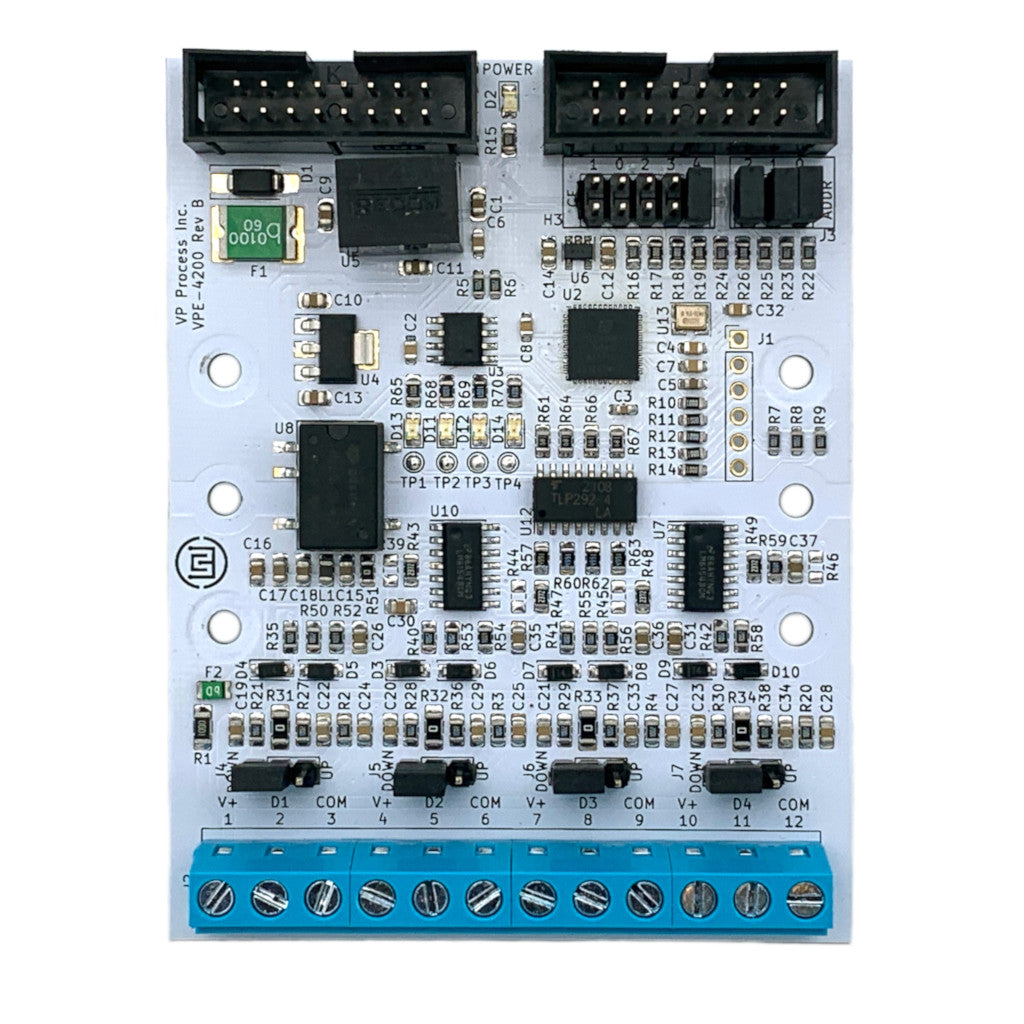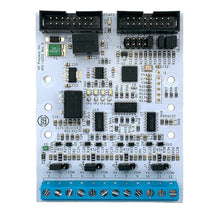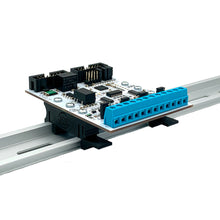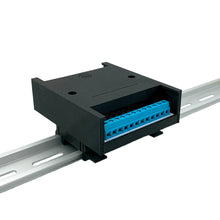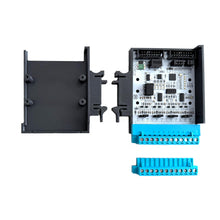PI-SPI-DIN-4FREQ Raspberry Pi Frequency / Pulse Counter I/O Module
Regular price
$125.00 USD
Sale
The PI-SPI-DIN-4FREQ is a four channel isolated Frequency / Pulse Counter / Digital Input I/O Module for the PI-SPI-DIN series of I/O Modules. The SPI communication allows for simple register reads of input values.
Block Diagram:

Specifications:
- All Functions run Simultaneously allowing any combination of inputs types
- Frequency measurement with fixed (one second) or variable (up to 100 second) sample period
- Five jumper selectable CE (Chip Enable) lines
- Three Address Jumpers allows for 8 units per CE selection
- 0-24 VDC OR 0-15 VAC capable inputs
- NPN, PNP or FLOATING input per channel (Jumper Selectable)
- Optical Isolation between inputs to SPI communication and power
(Inputs are not isolated from each other) - Frequency Range: 0.01 Hz to 100 kHz
- Resolution: 0.001 Hz
- Trigger Voltage: 2.5V (Min) under ideal conditions
(Can be adjusted by simple resistor value change) - DC coupling (Default)
- AC coupling (Requires removal of shorting resistor)
- Input Amplification capability (Requires installation of Gain resistor on a channel by channel basis
The PI-SPI-DIN-4FREq is available in four versions:
-PCB
 -CLIP PCB with DIN Clips
-CLIP PCB with DIN Clips

-ENC Horizontal DIN Enclosure

-V Vertical DIN Enclosure c/w Removable Terminal Block

Default limits for Frequency Counter:
2.5V min at 0 - 5 KHz sine wave
2.6V min at 5 - 15 KHz sine wave
2.7V min at 15 - 25 KHz sine wave
2.8V min at 25 - 35 KHz sine wave
2.9V min at 35 - 50 KHz sine wave
3.1V min at 50 - 55 KHz sine wave
3.2V min at 55 - 60 KHz sine wave
3.3V min at 60 - 65 KHz sine wave
3.4V min at 65 - 70 KHz sine wave
3.6V min at 70 - 75 KHz sine wave
3.7V min at 75 - 80 KHz sine wave
3.9V min at 80 - 85 KHz sine wave
4.0V min at 85 - 90 KHz sine wave
4.1V min at 90 - 95 KHz sine wave
4.2V min at 95 - 100 KHz sine wave
2.5V min at 5 - 35 KHz square wave
2.6V min at 35 - 60 KHz square wave
2.7V min at 60 - 75 KHz square wave
2.8V min at 75 - 85 KHz square wave
2.9V min at 85 - 100 KHz square wave
Sample Python Code:
#!/usr/bin/python3
import spidev
from time import sleep
spi = spidev.SpiDev()
def read_freq(ce, address, channel):
global spi
spi.open(0, ce)
spi.max_speed_hz = 100000
address = address % 8
channel = channel % 4
buf = spi.xfer([address << 1, channel, 0x00, 0x00, 0x00, 0x00])
spi.close()
return (buf[2] << 24) + (buf[3] << 16) + (buf[4] << 8) + buf[5]
def read_freq_variable(ce, address, channel):
global spi
spi.open(0, ce)
spi.max_speed_hz = 100000
address = address % 8
channel = channel % 4
buf = spi.xfer([address << 1, channel + 0x09, 0x00, 0x00, 0x00, 0x00])
spi.close()
cycles = (buf[2] << 24) + (buf[3] << 16) + (buf[4] << 8) + buf[5]
value = round(24000000 / cycles, 3) if cycles > 0 else 0.0
return value
def read_pulse(ce, address, channel):
global spi
spi.open(0, ce)
spi.max_speed_hz = 100000
address = address % 8
channel = channel % 4
buf = spi.xfer([address << 1, channel + 0x04, 0x00, 0x00, 0x00, 0x00])
spi.close()
return (buf[2] << 24) + (buf[3] << 16) + (buf[4] << 8) + buf[5]
def read_di(ce, address, channel):
global spi
spi.open(0, ce)
spi.max_speed_hz = 100000
address = address % 8
channel = channel % 4
buf = spi.xfer([address << 1, 0x08, 0x00, 0x00, 0x00, 0x00])
spi.close()
return (buf[5] >> channel) & 1
while True:
ce = 0 # CE0-4 jumpers
address = 0 # ADDR 0-2 jumpers
# Read frequency counter
print('\n------------------------------------------------')
print('Channel 1 frequency:', read_freq(ce, address, 0), 'Hz')
print('Channel 2 frequency:', read_freq(ce, address, 1), 'Hz')
print('Channel 3 frequency:', read_freq(ce, address, 2), 'Hz')
print('Channel 4 frequency:', read_freq(ce, address, 3), 'Hz')
# Read pulse counter
print('Channel 1 pulses:', read_pulse(ce, address, 0))
print('Channel 2 pulses:', read_pulse(ce, address, 1))
print('Channel 3 pulses:', read_pulse(ce, address, 2))
print('Channel 4 pulses:', read_pulse(ce, address, 3))
# read DI
print('Channel 1 DI:', read_di(ce, address, 0))
print('Channel 2 DI:', read_di(ce, address, 1))
print('Channel 3 DI:', read_di(ce, address, 2))
print('Channel 4 DI:', read_di(ce, address, 3))
print('Channel 1 frequency (variable):', read_freq_variable(ce, address, 0), 'Hz')
print('Channel 2 frequency (variable):', read_freq_variable(ce, address, 1), 'Hz')
print('Channel 3 frequency (variable):', read_freq_variable(ce, address, 2), 'Hz')
print('Channel 4 frequency (variable):', read_freq_variable(ce, address, 3), 'Hz')
sleep(1)
Sample Screen Shot:


